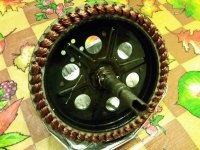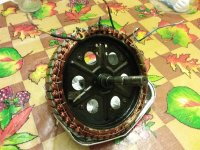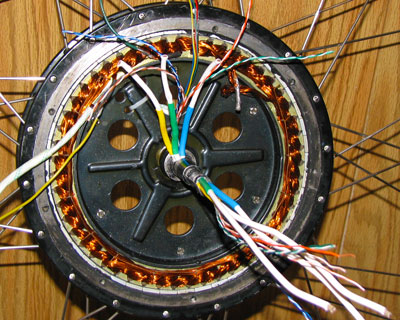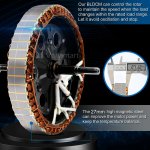polecat said:
I cleaned the stator with mineral spirits (checked some cleaning suggestions at another site). Before I used the mineral spirits, I tested it on a small section. Didn't soften or dissolve the winding varnish. Used the multimeter to verify.
FWIW, a regular multimeter can't tell you if the qualities of the windings have changed, such as if insulation is damaged between the layers of a single phase, etc. It takes an isolation tester or similar function to do that, or a resistance tester that can measure in milliohms or lower. To a typical multimeter, windigns are virtually a dead short resistance, about the same as the test leads themselves just being touched to each other.
I haven't used mineral spirits, so I don't know what they might or might not do. If theyr'e safe, then just pouring it on them mgiht wash stuff off, depending on what it is. But without some sort of mechanical action, scrubbing, wiping, etc., I don't know what they would remove. The mechanical action, more often than the solvent used, is what can damage windings or cause / exacerbate shorts between windings and stator laminations. (though depending on the existing damage/contaminants/etc., various solvents can cause various kinds of damage on their own).
Though I don't have a before picture, most of the oil, dirt, possibly carbon deposits, were located around the windings closest to the phase wires and hall sensors (I've removed the three hall sensors since; don't need them anymore with my sensorless controller)
If it was carbon deposits...they have to come from somewhere, and these motors are not open to the environment, so they should stay virtually pristine inside unless there is water intrusion, which creates corrosion, not carbon deposits. Also, carbon deposits are conductive, so they can also cause a "partial short".
In a brushed motor, it would come from brushes, but yours is brushless, and the only other common source of carbon deposits would be arcing from a short--but anything bad enough to leave visible deposits would also have a very obvious source spot with much more intense deposits.
If it's oil, that also has to come from somewhere, and there isn't a source for that in a motor like this, so it would have to come from some external source. Shouldn't be such a source on an escooter that could get into the hubmotor.
So...you have another mystery that might need solving, since whatever caused the deposits is another problem that may continue to cause other problems, even with a new motor. It's possible that the one problem created the other, or that they are completely unrelated.
I like your idea regarding a replacement stator. If I can find one that is close enough (size wise), that would work. Nothing wrong with my current motor housing and fastening bolts.
It has to be the *same* size in several specifics. The diameter of the stator laminations must be the same--too big and it will rub on the magnets or not fit inside. Too small and the air gap will be too large and the motor will not work as expected.
Also, had a crazy idea I'd like to run by you. Assuming the windings are shorting internally to the stator (almost certainly at this point), if I could electrically isolate and insulate the axle rod from the stator body, wouldn't that solve the short problem to the scooter frame?
It's not that there is a short to the frame, but that there is a short to the stator itself, which if more than one phase shorts to it means there is a short between phases (which often takes out the controller). Even if there's no inter-phase short, there can be multiple shorts within a single phase, essentially shorting out part of that phase so it doesn't drive the motor like it should, resulting in rough running, lower torque and/or speed, and potential damage to the controller depending on the current that flows and what exactly it does to the controller.
Anyway, to do that you'd have to re-engineer the stator supports so they can handle the torque of the stator against the axle, but be made of something nonconductive. They also have to be fairly precisely made, becuse you don't want any out of roundness between the stator and the magnet ring (rotor), the gap needs to be the same all the way around.
If you had the ability to lathe something like lexan, polycarbonate, or thick ABS, or some other tough plastic that's availalbe in thick enough sheets, you could make two discs with holes in them that fit over the axle, and within the stator inside circumference, so they butt right up on the existing stator supports.
Then once you have those fitting correctly, you can drill holes for bolts thru both discs and the stator supports in two circumferential rows, one near the axle, and one near the windings. Make sure you mark the alignments of everything, so it all comes out exactly the same way it was.
Then you can remove the discs, and cut the stator supports between the two rows of holes. You must be careful to mask off the windings and laminations so you don't get metal dust in them, or accidentally nick any of them.
Then you can put the discs back in, each on it's correct side and alignment, and bolt them to the stator supports.
Now it is electrically isolated, and theoreticaly mechanically supported. (how well-suported you'll have to put it together as a motor to find out, unfortunately).
HOwever: this only isolates the stator from the axle, it doesn't isolate the windings from the stator, so if more than one winding is (or becomes) shorted to the stator, theyre' also now shorted to each other, and taht's where the problems start.
I already tested the phase coils, they all seem to be intact.
Tested how, exactly?
Were they tested separately, or while still connected to each other?





